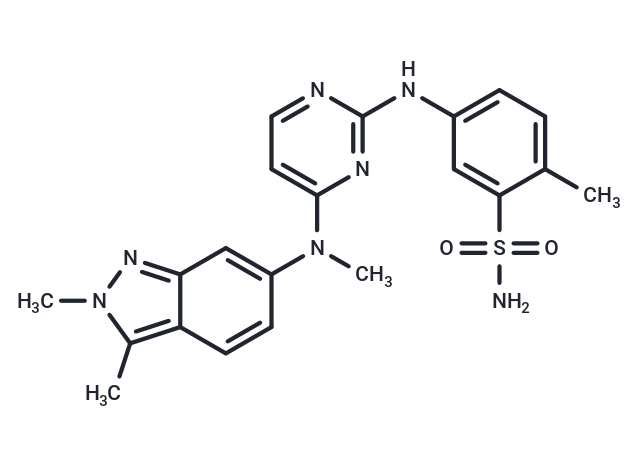购物车
- 全部删除
 您的购物车当前为空
您的购物车当前为空

Pazopanib (GW786034) 是一种蛋白酪氨酸激酶抑制剂,抑制 VEGFR1、VEGFR2、VEGFR3、PDGFRβ、c-Kit、FGFR1 和 c-Fms (IC50=10/30/47/84/74/140/146 nM)。Pazopanib 具有抗肿瘤活性。

Pazopanib (GW786034) 是一种蛋白酪氨酸激酶抑制剂,抑制 VEGFR1、VEGFR2、VEGFR3、PDGFRβ、c-Kit、FGFR1 和 c-Fms (IC50=10/30/47/84/74/140/146 nM)。Pazopanib 具有抗肿瘤活性。
| 规格 | 价格 | 库存 | 数量 |
|---|---|---|---|
| 10 mg | ¥ 292 | 现货 | |
| 25 mg | ¥ 472 | 现货 | |
| 50 mg | ¥ 783 | 现货 | |
| 100 mg | ¥ 1,160 | 现货 | |
| 200 mg | ¥ 1,910 | 现货 | |
| 500 mg | ¥ 3,590 | 现货 | |
| 1 mL x 10 mM (in DMSO) | ¥ 432 | 现货 |
| 产品描述 | Pazopanib (GW786034) is an inhibitor of protein tyrosine kinases that inhibits VEGFR1, VEGFR2, VEGFR3, PDGFRβ, c-Kit, FGFR1, and c-Fms (IC50=10/30/47/84/74/140/146 nM). Pazopanib has antitumor activity. |
| 靶点活性 | VEGFR2:30 nM, VEGFR3:47 nM, VEGFR1:10 nM, PDGFR:84 nM, c-Kit:74 nM |
| 体外活性 | 方法: SCLC 细胞系 NCI-H446 和 NCI-H82 用 Pazopanib (0.01-30 µM) 处理 24-72 h,通过 CCK-8 assay 检测细胞活力。 结果: Pazopanib 以剂量和时间依赖的方式显著降低了 NCI-H446 细胞的增殖,24 h 时 IC50 值为 1.05 µM。Pazopanib 还可以以剂量和时间依赖的方式诱导 NCI-H82 细胞中的强效细胞死亡,24 h 的 IC50 为 1.298 µM。Pazopanib 显著拮抗小细胞肺癌细胞增殖。[1] 方法: 人结直肠癌细胞 HCT-116 用 Pazopanib (1-20 µM) 处理 3-24 h,通过 Western Blot 检测靶点蛋白表达水平。 结果: Pazopanib 显著诱导了 PUMA 的表达,这是时间和剂量依赖性的。[2] |
| 体内活性 | 方法: 为检测体内抗肿瘤活性,将 Pazopanib (30 mg/kg,suspended in 0.5% hydroxypropylmethyl cellulose and 0.1% Tween-80 in water) 灌胃给药给携带 NCI-H446 异种移植物的 NOD-SCID 小鼠,每天一次,持续两周。 结果: Pazopanib 的给药显著抑制了 NCI-H446 异种移植物的生长。[1] |
| 激酶实验 | VEGFR enzyme assays for VEGGR1, VEGFR2, and VEGFR3 are run in homogeneous time-resolved fluorescence (HTRF) format in 384-well microtiter plates using a purified, baculovirus-expressed glutathione-S-transferase (GST) fusion protein encoding the catalytic c-terminus of human VEGFR receptor kinases 1, 2, or 3. Reactions are initiated by the addition of 10 μL of activated VEGFR2 kinase solution [final concentration, 1 nM enzyme in 0.1 M 4-(2-hydroxyethyl)-1-piperazineethanesulfonic acid (HEPES), pH 7.5, containing 0.1 mg/mL bovine serum albumin (BSA), 300 μM dithiothreitol (DTT)] to 10 μL substrate solution [final concentration, 360 nM peptide, (biotin-aminohexyl-EEEEYFELVAKKKK-NH2), 75 μM ATP, 10 μM MgCl2], and 1 μL of titrated compound in DMSO. Plates are incubated at room temperature for 60 min, and then the reaction is quenched by the addition of 20 μL of 100 mM ethylene diamine tetraacetic acid (EDTA). After quenching, 20 μL HTRF reagents (final concentration, 15 nM Streptavidin-linked allophycocyanin, 1 nM Europium-labeled antiphosphotyrosine antibody diluted in 0.1 mg/mL BSA, 0.1 M HEPES, pH 7.5) is added and the plates incubated for a minimum of 10 min. The fluorescence at 665 nM is measured with a Wallac Victor plate reader using a time delay of 50 μs[1]. |
| 细胞实验 | Pazopanib is prepared in DMSO and then diluted to final concentration in medium[1]. The effect of Pazopanib on cell proliferation is measured using 5-bromo-2-deoxyuridine (BrdU) incorporation method using commercially available kits. HUVEC is seeded in medium containing 5% fetal bovine serum (FBS) in type 1 collagen coated 96-well plates and incubated overnight at 37°C, 5% CO2. The medium is aspirated from the cells, and various concentrations of Pazopanib in serum-free medium are added to each well. After 30 min, either VEGF (10 ng/mL) or bFGF (0.3 ng/mL) is added to the wells. Cells are incubated for an additional 72 h and BrdU (10 μM) is added during the last 18 to 24 h of incubation. At the end of incubation, BrdU incorporation in cells is measured by ELISA. Data are fitted with a curve described by the equation, y=Vmax(1?(x/(K+x))), where K is equal to the IC50[1]. |
| 别名 | 帕唑帕尼, GW786034 |
| 分子量 | 437.52 |
| 分子式 | C21H23N7O2S |
| CAS No. | 444731-52-6 |
| Smiles | CN(c1ccc2c(C)n(C)nc2c1)c1ccnc(Nc2ccc(C)c(c2)S(N)(=O)=O)n1 |
| 密度 | 1.40 g/cm3 |
| 存储 | Powder: -20°C for 3 years | In solvent: -80°C for 1 year | Shipping with blue ice. | |||||||||||||||||||||||||
| 溶解度信息 | Ethanol: < 1 mg/mL (insoluble or slightly soluble) H2O: < 1 mg/mL (insoluble or slightly soluble) DMSO: 20 mg/mL (45.71 mM) | |||||||||||||||||||||||||
溶液配制表 | ||||||||||||||||||||||||||
DMSO
| ||||||||||||||||||||||||||
评论内容